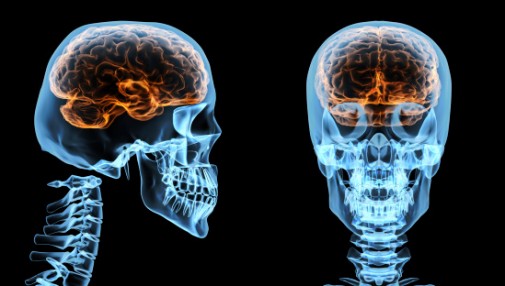Anatomy of a brain injury

Newton’s laws of motion say that an object in motion stays in motion unless acted upon by an outside force.
Imagine a soccer player running down the field who stops suddenly using his head to make contact with a fast-moving ball. The ball’s motion gets stopped by the head. The brain’s motion gets stopped by the skull. This gets repeated game after game. That’s what happens when a brain injury occurs. The brain can literally get knocked into your skull.
“The skull is the natural helmet to protect the brain,” explains Dr. Raina Gupta, a neurologist with Advocate Medical Group in Chicago. “And there’s fluid surrounding the brain to help absorb injury, but there will be some impact on the brain that the skull simply can’t handle, and we’re slowly learning how extensive that impact can be,” she says.
Severe consequences
Dr. Gupta says recent research reveals that brain injuries or concussions cause the brain to age prematurely because the brain is affected at the cellular level.
“The changes that happen at the level of the cell of the brain mimic advanced dementia,” says Dr. Gupta.
In both dementia and concussions, abnormal proteins are deposited in the cells.
“We think these abnormal proteins accumulate over time, so if you look at a 40-year-old professional athlete’s brain who’s has repeated concussions, it could resemble an 80-year-old person’s brain who was not an athlete. So it would look like the athlete had prematurely advanced dementia,” explains Dr. Gupta, who holds concussion clinics.
It’s possible to not even know you have sustained a brain injury, she says, so particularly for athletes, it’s important to know the signs. Physicians often use a standardized sports concussion assessment tool that identifies signs within the first 24 to 48 hours that an athlete may have a concussion, including:
- Having a headache that gets worse
- Feeling very drowsy or can’t be awakened
- Inability to recognize people or places
- Repeatedly vomiting
- Behaving unusually, seeming confused, irritability
- Having seizures
- Feeling weakness or numbness in limbs
- Trouble with balance
- Slurring speech
It’s difficult to know how significant an injury is until the symptoms show up so if you suspect you might have had an injury, Dr. Gupta says go to the emergency room or call your doctor and monitor your symptoms over time.
Prevention is key
Unfortunately, there are no magic pills or ways to reverse the process, says Dr. Gupta.
“However, cognitive rest improves time to recovery. I feel that increased total sleep may have the potential to improve time to recovery as well,” she says. Those with concussions need more sleep than usual because sleep helps the brain to recover.
She also explains that after an initial injury, people improve, however, after repeated injury (also known as chronic traumatic encephalopathy), “you can have retained deficits, and may be left with long-term consequences, so the most important thing is prevention.”
Dr. Gupta believes that in addition to improving protection, such as better helmets, she says that policy changes are needed in youth sports, and an increased awareness of what long-term consequences of head injuries can be.
Even President Obama recognizes that the growth in concussions, particularly from sports, needs attention. In an interview, he once said, “If I had a son, I’d have to think long and hard before I let him play football.”
Good places to start for policy change might be no direct head hits in football during practice, only in games, and no heading the ball during soccer practice.
“With increased awareness we can keep help to keep our kids safe. This may lead to changes in the rules of the game all together. This is one policy we can contribute to as a society,” Dr. Gupta says.
Related Posts
Comments
5 Comments
About the Author
health enews staff is a group of experienced writers from our Advocate Health Care and Aurora Health Care sites, which also includes freelance or intern writers.


















This is really interesting! Hopefully as we learn more about the brain we can do more to protect the brains of kids playing sports in the future.
I need a helmet for when I run and accidentally trip and fall multiple times weeks apart, which is how I suffered mine. The falls were nothing compared to the weeks of recovery afterward, as the writer and doctor allude to. Brain injuries and concussions are a fascinating, ultra-important area of medicine.
They don’t have to be sport-related either. While walking my dogs this winter I slipped on a sheet of ice and cracked my head hard – harder than anything I’ve experienced before. That was early in January and I still have periodic headaches (migraines?) that make me want to curl up an sleep in a dark quiet room for hours. I fight the urge to go into hiding, but maybe, after reading this, I’ll succumb to the desire to sleep and try to let the brain heal. I’m surely not winning the battle by fighting it.
Hi, Joolie,
If the problem persists, I would encourage you to consult your physician and/or a neurologist who might be able to help you get some relief. Having to suffer through what could be migraines is simply awful. Wishing you a return to good health!
Too bad photos of what a brain-damaged brain looks like at death after years of repeated rain trauma…f MRI is also shocking, showing which areas of the rain aren’t actually working …
It’s shocking enough to get people knocking down their MP’s doors to lobby for revisions now immediately…to game rules, to NHS protocols, etc…